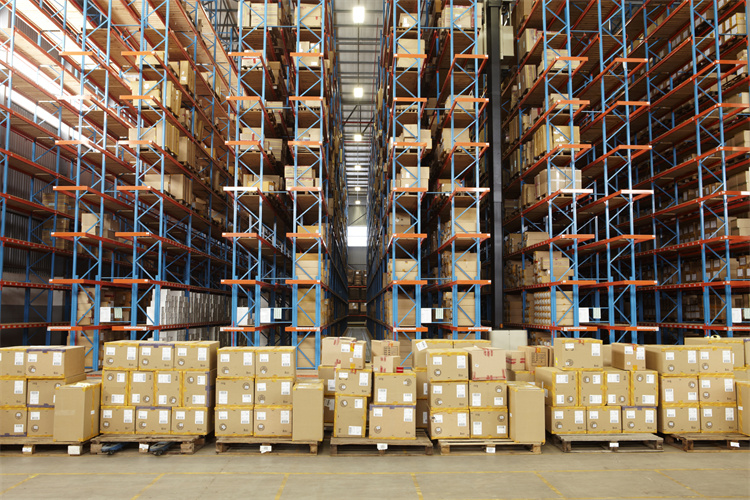Key Features of a Modern WMS: Beyond Basic Inventory Tracking

Basic inventory tracking often falls short in today’s fast-paced warehouse environments. It struggles to keep up with growing demands, leading to inefficiencies and missed opportunities. For instance:
Companies with over 1,000 employees allocate an average of $402,267 to warehouse management systems, while smaller businesses spend just $57,200.
Nearly 39% of buyers actively seek advanced features, showing that basic systems no longer suffice.
Surprisingly, 15-20% of warehouses still operate without a WMS, missing out on significant efficiency gains.
A modern WMS transforms operations by automating tasks, improving accuracy, and scaling effortlessly. It enhances labor efficiency by up to 40%, reduces inventory by 20%, and cuts errors by 80%. These benefits make it indispensable for businesses aiming to stay competitive.
Key Takeaways
A modern WMS uses technology to make warehouse tasks easier and faster.
Using a WMS can cut mistakes by 80%, making work smoother and customers happier.
Tracking inventory in real-time helps keep the right amount of stock, avoiding too much or too little.
Connecting a WMS with current systems improves data handling and lowers costs by 15-20%.
Getting a modern WMS helps businesses stay ahead and grow successfully.
Understanding a Modern WMS
Definition and Purpose
A modern WMS goes far beyond basic inventory tracking. It acts as the backbone of warehouse operations, coordinating and optimizing every step of the process. From receiving goods to shipping them out, it ensures everything runs smoothly.
Modern WMS solutions enhance traditional inventory management with advanced tracking and control mechanisms.
They automate tasks like picking, packing, and shipping, which reduces errors and speeds up workflows.
Businesses often see improved accuracy, better labor efficiency, and lower costs after implementing a WMS.
Think of it as a conductor in an orchestra. While each instrument (or warehouse task) plays its part, the WMS ensures harmony and efficiency across the board.
Advanced Features of a Modern WMS

Real-Time Inventory Tracking
Benefits of Continuous Stock Monitoring
Real-time inventory tracking is a game-changer for warehouses. It ensures businesses always know what’s in stock, reducing the risk of overstocking or running out of products. By implementing technologies like RFID, warehouses can cut manual counting time by 70% and achieve inventory accuracy rates as high as 99.5%. These advancements help businesses maintain optimal stock levels, ensuring the right products are available when needed.
This feature also minimizes errors and improves customer satisfaction. Accurate inventory counts mean fewer returns and better demand planning. Companies that adopt real-time tracking often see significant cost savings and operational improvements.
Applications in Daily Operations
In daily operations, real-time tracking simplifies tasks like order picking and restocking. Workers can quickly locate items, reducing delays and improving efficiency. For example, automated systems can alert staff when stock levels drop below a certain threshold, ensuring timely replenishment. This proactive approach keeps operations running smoothly and enhances overall productivity.
Benefit | Description |
|---|---|
Inventory Accuracy | Real-time tracking and automated stock management lead to high levels of inventory accuracy. |
Operational Efficiency | Enhanced processes reduce time and labor costs, improving overall efficiency in warehouse operations. |
Cost Reductions | Minimizing overstock and stockouts leads to significant cost savings for businesses. |
Seamless System Integration
ERP and CRM Compatibility
A modern WMS integrates seamlessly with ERP and CRM platforms, creating a unified system for managing operations. This compatibility allows real-time data synchronization, improving decision-making and reducing errors. Businesses benefit from enhanced efficiency and a better customer experience, as they can access accurate, up-to-date information across all systems.
Unified Data Management Benefits
Unified data management streamlines warehouse operations by consolidating information into a single platform. This reduces the need for manual data entry, cutting down on errors and saving time. Companies that integrate their WMS with other systems often see a 15% reduction in operational costs and achieve ROI within two years. These benefits make integration a valuable feature for any growing business.
Metric | Evidence |
|---|---|
Cost Savings | 15% reduction in operational costs |
Payback Period | Under two years for ROI from integration |
Intelligent Labor Management
Workforce Optimization
Intelligent labor management systems (LMS) optimize resource allocation by analyzing performance metrics and sales data. These systems use smart algorithms to assign tasks efficiently, especially during peak seasons. By forecasting labor needs, businesses can reduce overtime and improve financial efficiency. This approach ensures the right number of employees are scheduled, saving costs and boosting productivity.
Productivity and Performance Tracking
Modern LMS tools track labor and goods flow in real time, providing valuable insights for decision-making. Managers can monitor employee performance and identify areas for improvement. Over time, this data helps businesses refine their processes, leading to better resource allocation and higher productivity. Companies that adopt LMS often see significant labor cost savings and improved operational efficiency.
💡 Tip: Intelligent labor management not only enhances productivity but also creates a more balanced workload for employees, improving job satisfaction.
Comprehensive Analytics and Reporting
Data-Driven Decision Making
A modern WMS empowers businesses to make smarter decisions by leveraging comprehensive analytics. Tracking key performance indicators (KPIs) like order fulfillment rates, picking accuracy, and labor productivity provides valuable insights. These metrics highlight areas for improvement and help managers optimize operations. For example, analyzing order fulfillment processes can reveal bottlenecks, enabling businesses to streamline workflows and reduce delays.
Real-time tracking also plays a crucial role. It ensures accurate inventory levels, preventing stockouts and overstocking. This not only saves costs but also keeps customers satisfied by ensuring product availability. By focusing on the right KPIs, businesses gain the tools they need for continuous improvement and cost-effective operations.
Pro Tip: Regularly review analytics to identify trends and adjust strategies. This proactive approach keeps warehouses running efficiently.
Predictive Analytics for Demand Planning
Predictive analytics takes warehouse management to the next level. By analyzing historical data and market trends, businesses can forecast demand more accurately. This helps in planning inventory levels, reducing waste, and avoiding stock shortages. For instance, a company can predict seasonal demand spikes and prepare accordingly, ensuring smooth operations during peak periods.
Additionally, predictive tools assist in labor planning. Managers can allocate resources based on anticipated workloads, minimizing overtime and improving productivity. With these capabilities, a modern WMS ensures warehouses stay ahead of demand fluctuations.
Automation and Robotics Support
Integration with Automated Systems
Automation transforms warehouse operations by streamlining repetitive tasks. A modern WMS integrates seamlessly with automated systems like conveyor belts, robotic arms, and Automated Storage and Retrieval Systems (ASRS). This integration reduces reliance on manual labor, enabling higher order throughput and faster processing times.
For example, robotics can handle tasks like picking and transporting goods, significantly reducing errors. These systems also adapt to changing demands, ensuring flexibility and efficiency. Businesses that embrace automation often see improved productivity and lower operational costs.
Examples of Robotics in Warehousing
Robotics plays a vital role in modern warehouses. Piece-picking robots, for instance, automate the selection and transportation of items. This speeds up the picking process and minimizes human error. Autonomous Mobile Robots (AMRs) navigate warehouses independently, optimizing routes and reducing travel time.
Collaborative robots, or cobots, work alongside human employees, enhancing efficiency without replacing the workforce. These technologies not only improve accuracy but also create safer working environments by handling hazardous tasks. By integrating robotics, warehouses can scale operations and meet growing demands with ease.
Warehouse Layout Optimization
Enhancing Storage Efficiency
An optimized warehouse layout maximizes storage space and improves accessibility. Businesses can use techniques like ABC analysis to categorize inventory based on demand. High-demand items are placed closer to shipping areas, reducing travel time for workers.
Real-time visibility further enhances efficiency. Managers can track inventory locations and make informed decisions about space utilization. This approach ensures that every square foot of the warehouse is used effectively, minimizing wasted space and boosting productivity.
Improving Retrieval Processes
Efficient retrieval processes are essential for fast order fulfillment. A logical flow design streamlines the movement of goods, minimizing backtracking and delays. For example, reconfiguring the layout to group similar items together can speed up picking times.
Automation also plays a role here. Systems like ASRS retrieve items quickly and accurately, reducing the time workers spend searching for products. By focusing on retrieval efficiency, businesses can improve customer satisfaction and handle larger order volumes effortlessly.
Emerging Trends in Modern WMS Technology

Sustainability in Warehouse Management
Energy-Efficient Operations
Sustainability has become a priority for warehouses, and energy-efficient operations are leading the charge. Modern WMS solutions now include energy management features that help businesses reduce their carbon footprint. For example, optimized routing systems cut fuel consumption by streamlining equipment usage. Green warehouses, which adopt these practices, can lower operating costs by up to 20%.
Additionally, tools for tracking carbon emissions allow businesses to monitor and improve their environmental impact. With 65% of consumers favoring eco-friendly brands, adopting sustainable practices isn’t just good for the planet—it’s also good for business.
Reducing Waste with Smarter Systems
Modern WMS technologies minimize waste by improving inventory management. Smarter systems prevent overstocking and reduce spoilage by tracking expiration dates. Paperless operations also play a role, cutting down on unnecessary waste. These advancements not only save money but also align with growing consumer demand for sustainable practices.
AI and Machine Learning Applications
Enhancing Predictive Capabilities
Artificial intelligence (AI) and machine learning (ML) are transforming warehouse management. These technologies analyze large datasets to uncover patterns and predict trends. For instance, companies like Unilever have seen a 75% improvement in forecast accuracy by using AI-powered analytics. Predictive tools also optimize stock levels, ensuring businesses meet demand without overstocking.
AI-driven forecasting reduces errors by up to 50%, making it a game-changer for warehouses. By leveraging historical data from IoT sensors and RFID tags, businesses can plan more effectively and avoid costly mistakes.
Automating Repetitive Tasks
AI and ML also excel at automating repetitive tasks. Machine learning algorithms adjust workflows in real time, improving efficiency. For example, automated decision-making systems can allocate resources based on current demand. This reduces manual intervention and allows employees to focus on more strategic tasks, boosting overall productivity.
Robotics in Warehousing
Autonomous Mobile Robots (AMRs)
Autonomous Mobile Robots (AMRs) are revolutionizing warehouse operations. Unlike Automated Guided Vehicles (AGVs), AMRs use advanced sensors and AI for dynamic navigation. This flexibility allows them to adapt to changing environments, making them ideal for modern warehouses. Although AMRs require a higher initial investment, their lower operational costs make them a smart long-term choice.
Collaborative Robots (Cobots)
Collaborative robots, or cobots, work alongside human employees to enhance efficiency. These robots handle repetitive or hazardous tasks, creating a safer work environment. For example, PUMA’s adoption of robotics has improved employee satisfaction by fostering a clean and tech-driven workplace. Cobots not only boost productivity but also support a more harmonious human-robot collaboration.
Upgrading to a modern WMS is no longer a luxury—it’s a necessity for businesses aiming to thrive in today’s competitive landscape. Moving beyond basic inventory tracking unlocks a world of possibilities, from real-time inventory accuracy to seamless automation. Companies adopting advanced features consistently report significant gains in efficiency, cost savings, and customer satisfaction.
Case Study | Improvement Metrics | |
|---|---|---|
Automated Picking Technology | Increased picking productivity by 30%, Reduced order processing time by 25% | |
IoT-enabled RFID Implementation | Inventory accuracy improved from 85% to 99.5%, Order picking time reduced by 40%, Reduced labor costs by 25% |
Businesses that embrace these innovations position themselves for long-term success. A modern WMS not only streamlines operations but also ensures scalability and adaptability for future growth. Now is the time to make the leap and stay ahead of the curve.
FAQ
1. What is the main purpose of a modern WMS?
A modern WMS optimizes warehouse operations by automating tasks, improving inventory accuracy, and enhancing efficiency. It helps businesses manage resources better, reduce errors, and scale operations to meet growing demands.
2. How does a modern WMS improve inventory accuracy?
It uses real-time tracking tools like RFID and barcode scanning. These technologies ensure accurate stock counts, reduce discrepancies, and provide instant updates on inventory levels.
3. Can small businesses benefit from a modern WMS?
Absolutely! A modern WMS helps small businesses save time, reduce costs, and improve customer satisfaction. It streamlines processes, making operations more efficient even with limited resources.
💡 Tip: Start with a scalable WMS that grows with your business needs.
4. Is it difficult to integrate a WMS with existing systems?
Not at all. Most modern WMS solutions offer seamless integration with ERP, CRM, and other tools. This ensures unified data management and smoother workflows.
5. What are the cost-saving benefits of a modern WMS?
A WMS reduces labor costs, minimizes inventory errors, and prevents overstocking. Businesses often see a 15-20% reduction in operational expenses after implementation.
Note: Investing in a WMS pays off quickly, with most companies achieving ROI within two years.
See Also
Enhance Your Business Through Innovative Inventory Strategies
Utilizing Robotics in Logistics to Boost Warehouse Efficiency
The Importance of Automating Your Warehouse Operations
Understanding Robotic Automation for Improved Warehouse Efficiency
Exploring Benefits of Automation in Modern Manufacturing Warehouses
